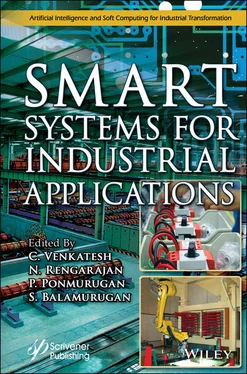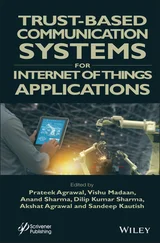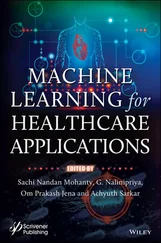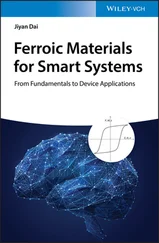Smart Systems for Industrial Applications
Здесь есть возможность читать онлайн «Smart Systems for Industrial Applications» — ознакомительный отрывок электронной книги совершенно бесплатно, а после прочтения отрывка купить полную версию. В некоторых случаях можно слушать аудио, скачать через торрент в формате fb2 и присутствует краткое содержание. Жанр: unrecognised, на английском языке. Описание произведения, (предисловие) а так же отзывы посетителей доступны на портале библиотеки ЛибКат.
- Название:Smart Systems for Industrial Applications
- Автор:
- Жанр:
- Год:неизвестен
- ISBN:нет данных
- Рейтинг книги:3 / 5. Голосов: 1
-
Избранное:Добавить в избранное
- Отзывы:
-
Ваша оценка:
- 60
- 1
- 2
- 3
- 4
- 5
Smart Systems for Industrial Applications: краткое содержание, описание и аннотация
Предлагаем к чтению аннотацию, описание, краткое содержание или предисловие (зависит от того, что написал сам автор книги «Smart Systems for Industrial Applications»). Если вы не нашли необходимую информацию о книге — напишите в комментариях, мы постараемся отыскать её.
The prime objective of this book is to provide an insight into the role and advancements of artificial intelligence in electrical systems and future challenges.
Audience
Smart Systems for Industrial Applications — читать онлайн ознакомительный отрывок
Ниже представлен текст книги, разбитый по страницам. Система сохранения места последней прочитанной страницы, позволяет с удобством читать онлайн бесплатно книгу «Smart Systems for Industrial Applications», без необходимости каждый раз заново искать на чём Вы остановились. Поставьте закладку, и сможете в любой момент перейти на страницу, на которой закончили чтение.
Интервал:
Закладка:
The anatomical relationship that exists between healthy organs and pathologic was well understood by surgeons by exhibiting the preoperative available images. Particularly if the organs of interest are immobile, then AR-based surgeries are successfully implemented. The recent application of AR in improved myoma detection and fibroid mapping are very good examples [36]. Some other similar techniques are used in gynecologic oncology for the identification of sentinel lymph nodes that have reduced the morbidity incorporated with group lymphadenectomy [37]. The communication technologies associated with three-dimensional printing to create physical models for better visualization of organ configuration offers an AR, which is unrealizable through other traditional imaging techniques. With recent techniques, advanced communication-enabled 3D printers can emulate various tissue types [38]. Given the changes in myoma size, position, and length within a uterus, 3D printing of a uterus can help the surgeon come up with good prior operative planning. In this manner, communication technologies associated with AI and AR offer a great deal in helping gynecological surgeons.
We concluded that further research and application of VR and AR in the healthcare and communication technologies are necessary. The summary of above discussed article is given in Table 1.6.
Table 1.6 Impact of AI-driven augmented and virtual reality in healthcare.
| Source | Subject matter | Methods proposed | Performance analysis |
| [30] | Clinical applications | Deep learning–based diagnosis | Detects metastases in hematoxylin and eosin–stained tissue sections of lymph nodes of women with breast cancerAchieves 95% CI using 3-layer CNN |
| [31] | Clinical applications -Radiology | Clinical decision-making using CNN | Achieves 20% improvement over sonographer readings after training with ultrasound images of left and right carotid artery from 203 patients. |
| [32–34] | Clinical applications -survival prediction | Probabilistic Neural NetworkMulti-layer PerceptronGene expression classifierSupport Vector MachineRadial Basis Neural NetworkK-means algorithm | Trained with 23 demographic, tumor-related parameters and selected perioperative data from 102 patients.PNN achieves high prediction ability with an accuracy of 0.892 and sensitivity of 0.975 |
| [35] | Surgical Applications | Rotational matrix and translation vector algorithm to reduce the geometric error | Improves the video accuracy by 0.30–0.40 mm (in terms of overlay error)Enhances processing rate to 10–13 frames/sDepth perception is increased by 90–100 mm |
| [36–38] | Surgical Applications | Feasibility of laparoscopic Sentinel Lymph Node (SLN) staging | 245 SLN nodes were removed out of 370 lymph nodes from 87 patients. |
References
1. Gaddi, A., Capello, F., Manca, M., eHealthcare and Quality of Life , Springer, Verlag Italia, 2014.
2. Oh, H., Rizo, C., Enkin, M., Jadad, A., What is ehealth (3): a systematic review of published definitions. J. Med. Internet Res ., 7, 1, e1, 2005.
3. Gurung, M.S., Dorji, G., Khetrapal, S., Ra, S., Babu, G.R., and S Krishnamurthy, R.S., Transforming healthcare through Bhutan’s digital health strategy: progress to date. WHO South-East Asia Journal of Public Health, pp. 77–82, doi: 10.4103/2224-3151.264850.
4. Zulman, D.M., Jenchura, E.C., Cohen, D.M., Lewis, E.T., Houston, T.K., Asch, S.M., How Can eHealth Technology Address Challenges Related to Multimorbidity Perspectives from Patients with Multiple Chronic Conditions. J. Gen. Intern. Med ., 30, 8, 1063–70, 2015.
5. Laxminarayan, S. and Istepanian, R.S.H., Unwired e-med: the next generation of wireless and internet telemedicine systems. IEEE Trans. Inf. Technol. Biomed ., 4, 3, 189–193, Sept 2000, https://doi.org/10.1109/TITB.2000.5956074.
6. Germanakos, P., Mourlas, C., Samaras, G., A mobile agent approach for ubiquitous and personalized ehealth information systems, in: Proceedings of the Workshop on ‘Personalization for e-Health’ of the 10th International Conference on User Modeling (UM’05) , Edinburgh, pp. 67–70, 2005.
7. Lee, J., Smart health: concepts and status of ubiquitous health with smartphones, in: ICTC 2011 , pp. 388–389, Sept 2011, https://doi.org/10.1109/ICTC.2011.6082623.
8. Wu, G., Talwar, S., Johnsson, K., Himayat, N., Johnson, K.D., M2M: from mobile to embedded internet. IEEE Commun. Mag ., 49, 4, 36–43, April 2011, https://doi.org/10.1109/MCOM.2011.5741144.
9. Jennifer Bresnick, J., Top 12 Ways Artificial Intelligence Will Impact Healthcare, World medical Innovation Forum, 2018, accessed 30 April 2018, https://healthitanalytics.com/news/top-12-ways-artificial-intelligence-will-impact-healthcare.
10. Micah Castelo, M., The Future of Artificial Intelligence in Healthcare, Healthtech Magazine, 2020, accessed 26 Feb 2020, https://healthtechmagazine.net/article/2020/02/future-artificial-intelligence-healthcare.
11. Sandeep Reddy (November 5th 2018). Use of Artificial Intelligence in Healthcare Delivery, eHealth - Making Healthcare Smarter, Thomas F. Heston, IntechOpen, DOI: 10.5772/intechopen.74714. Available from: https://www.intechopen.com/books/ehealth-making-health-care-smarter/use-of-artificial-intelligence-in-healthcare-delivery.
12. Murdoch, T.B. and Detsky, A.S., The inevitable application of big data to healthcare. JAMA , 309, 1351–2, 2013.
13. Kolker, E., Özdemir, V., Kolker, E., How Healthcare can refocus on its Super-Customers (Patients, n=1) and Customers (Doctors and Nurses) by Leveraging Lessons from Amazon, Uber, and Watson. OMICS , 20, 329–33, 2016.
14. Dilsizian, S.E. and Siegel, E.L., Artificial intelligence in medicine and cardiac imaging: harnessing big data and advanced computing to provide personalized medical diagnosis and treatment. Curr. Cardiol. Rep ., 16, 441, 2014.
15. Bhavnani, S.P., Narula, J., Sengupta, P.P., Mobile technology and the digitization of healthcare. Eur. Heart J ., 37, 1428–1438, 2016, https://doi.org/10.1093/eurheartj/ehv770.
16. Tison, G.H., Sanchez, J.M., Ballinger, B., Singh, A., Olgin, J.E., Pletcher, M.J., Vittinghoff, E., Lee, E.S., Fan, S.M., Gladstone, R.A. et al ., Passive detection of atrial fibrillation using a commercially available smartwatch. JAMA Cardiol ., 3, 409–416, 2018, https://doi.org/10.1001/jamacardio.2018.0136.
17. Sengupta, P.P., Huang, Y.M., Bansal, M., Ashrafi, A., Fisher, M., Shameer, K., Gall, W., Dudley, J.T., Cognitive machine-learning algorithm for cardiac imaging: a pilot study for differentiating constrictive pericarditis from restrictive cardiomyopathy. Circ. Cardiovasc. Imaging , 9, e004330, 2016, https://doi.org/10.1161/CIRCIMAGING.115.004330.
18. Tsang, W., Salgo, I.S., Medvedofsky, D., Takeuchi, M., Prater, D., Weinert, L., Yamat, M., Mor-Avi, V., Patel, A.R., Lang, R.M., Transthoracic 3D echocardiographic left heart chamber quantification using an automated adaptive analytics algorithm. JACC: Cardiovasc. Imaging , 9, 769–782, 2016, https://doi.org/10.1016/j.jcmg.2015.12.020.
19. Lancaster, M.C., Salem Omar, A.M., Narula, S., Kulkarni, H., Narula, J., Sengupta, P.P., Phenotypic clustering of left ventricular diastolic function parameters: patterns and prognostic relevance. JACC: Cardiovasc. Imaging , 12, 7, 1149–1161, 2018, https://doi.org/10.1016/j.jcmg.2018.02.005. [epub].
20. Zhang, J., Gajjala, S., Agrawal, P., Tison, G.H., Hallock, L.A., Beussink-Nelson, L., Lassen, M.H., Fan, E., Aras, M.A., Jordan, C. et al ., Fully automated echo-cardiogram interpretation in clinical practice. Circulation , 138, 1623–1635, 2018, ( https://doi.org/10.1161/CIRCULATIONAHA.118.034338).
Читать дальшеИнтервал:
Закладка:
Похожие книги на «Smart Systems for Industrial Applications»
Представляем Вашему вниманию похожие книги на «Smart Systems for Industrial Applications» списком для выбора. Мы отобрали схожую по названию и смыслу литературу в надежде предоставить читателям больше вариантов отыскать новые, интересные, ещё непрочитанные произведения.
Обсуждение, отзывы о книге «Smart Systems for Industrial Applications» и просто собственные мнения читателей. Оставьте ваши комментарии, напишите, что Вы думаете о произведении, его смысле или главных героях. Укажите что конкретно понравилось, а что нет, и почему Вы так считаете.












